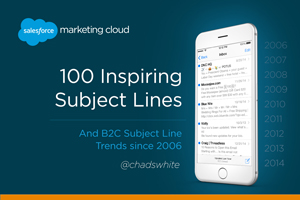
Get your FREE 30-day trial.
Please complete all fields.
 Almost all messages are more effective when they include an image. Tweets with images see substantially higher engagement and retweets. Having at least one image in a blog post is now standard practice. And it’s rare to see a promotional email that doesn’t include at least one image — if not several.
Almost all messages are more effective when they include an image. Tweets with images see substantially higher engagement and retweets. Having at least one image in a blog post is now standard practice. And it’s rare to see a promotional email that doesn’t include at least one image — if not several.
The newest frontier for images is in subject lines. As I discuss in Salesforce’s 100 Inspiring Subject Lines, special characters like stars and hearts started appearing in the subject lines of marketers’ emails in early 2012, and then emojis began appearing in subject lines last year.
Currently around 2% of B2C emails include a special character or an emoji. I expect their usage to slowly rise — perhaps doubling over the next couple of years — as marketers become more comfortable with these new subject line elements and become assured that they don’t negatively affect deliverability.
While not a blank canvas, there are hundreds and hundreds of special characters and emojis that are appropriate for marketing use. That gives you a lot of expressive range.
Let’s explore the three ways that visual elements can be used in subject lines and illustrate them with some real-life examples.
In these cases, special characters and emojis are simply used to separate two or more ideas, just as you would use a dash or colon; or are used at the beginning and/or end of the subject line, just as you would an asterisk or quotation marks. Stars and similarly generic special characters are most commonly used in this capacity. “Right arrow” characters are also sometimes used at the end of a subject line to mimic a call-to-action arrow button.
This Home Depot subject line is solid example of this in action. Especially since the series in the second half of the subject line includes “vertical bar” characters, the star character is nice, strong separator that creates a clear visual hierarchy. This arrangement has much more visual punch than if Home Depot had used a colon and commas instead.

2. Functionally
These are instances where the special character is just a fancier version of an existing character, such as a number.
This Neiman Marcus subject line is a particularly clever example of this type of usage, because it’s more than just a number replacement. The “7 in dark circle” character puns off the “well-rounded” in the subject line, and the character also mimics the treatment of the “7” in the body of the email.
The special characters in this Delta subject line have both functional and structural components. That’s because the “dark circle number” characters not only count off the steps, but also act like bullets, breaking the subject line up into easy-to-digest bits.
In these instances, the special character or emoji stands in for a word or idea, as in a pictogram, or reinforces or adds to the meaning of a portion of the subject line.
This subject line from the DNC is one of the purest examples of this tactic. It echoes the pictogram riddles that we did as children, setting a relaxed and playful tone for the email. But it’s also a super-efficient use of characters. It says in 19 characters what would be in the neighborhood of 85 characters if it were spelled out.
The approach in this Vera Bradley subject line is probably more widely applicable. In it, they use checkmark characters to check off a list of items. It’s effective because writing “check” doesn’t nearly have the same feel as using the character.
Similar to Vera Bradley, whose use of special characters evokes the action of checking off a list, Avaaz.org uses special characters to evoke the act of censorship in this subject line. The meaning is immediately clear and the large, dark box is very eye-catching in the inbox.
This tactic can also be used for branding purposes, as Jeep does in this subject line. Using bullet and “vertical bar” characters, they are able to make a pretty faithful representation of their logo. I’ve also seen a version of this where Jeep replaces the bullets with “black sun” characters to make it look like the headlights in their logo are on. Very clever.
Taking it up a notch is this Moosejaw subject line that deftly creates a $100 bill out of various characters. This is a higher order of ASCII art! It’s great to see brands pushing the boundaries of email creativity.
One of the drawbacks of special characters and emojis is that they aren’t supported on all email clients, so you’ll need to do some segmentation. However, platforms like the Apple Watch will add momentum to emoji usage and spur greater support across email clients.
At the same time, more emojis will surely be released in the months and years ahead, giving marketers an even broader visual vocabulary to explore. Plus, I wouldn’t be surprised to see branded emojis in the future. In the past, Gmail has experimented with allowing brands to bring .ico images into subject lines, so other image-based capabilities are on the radar screen as well.
Words are powerful. But images are even more powerful. It’s inevitable that in the years ahead we’ll see images become an even bigger part of subject line writing — perhaps to the point where it will be more like subject line designing.